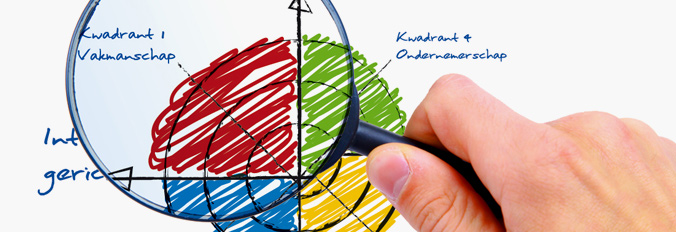Robert E. Quinn's competing values framework
Four important management models have been developed since the start of the 20th century.
1900 – 1925: The rise of the rational goal model and the internal process models
The first 25 years of this century was a period of vigorous growth and progress, leading to great affluence. This period was characterised by the rise of great individual industrial leaders: Henry Ford, Frederick Taylor. The first two management models were created.
Firstly the rational goal model: productivity and profit are the ultimate criteria for the effectiveness of the organisation. The goal - resources theory underlying this approach is based on the conviction that clear leadership produces productive results. The manager's task is to be a firm director and producer.
The second model, the internal process model, places the emphasis on processes such as the description of responsibilities, measurements, documentation and keeping records. The climate within the organisation is hierarchical, and all decisions reflect the existing rules, structures and traditions. The manager's task is to be a structured supervisor and coordinator.
1926 – 1950: the rise of the human relations model
Two very important events took place during this period: the stock market crash of 1929 and the Second World War. A number of fundamental changes in the structure of society gradually emerged. The trade unions, which had become an important force, focused on the level of wages and ensured that American workers constantly took home more money. Managers discovered that the rational goal model and the internal process models were not as effective as they had been in the past. Studies such as the famous Hawthorne study provided evidence for the need to pay more attention to the impact of relationships and informal processes on the performance of groups of people. The manager's task is to be a mentor and stimulator who responds alertly to signals.
1951 – 1975: the rise of the open system model
During this period the economy had to deal with a massive blow from the oil embargo. The assumptions about cheap energy and the way of life that was based on them were suddenly threatened. Technological progress became visible at an ever-increasing pace during this period. The computer arrived. The values within society altered dramatically. Authority and institutions were questioned everywhere. A more individualistic and conservative attitude started to take root. The level of knowledge within organisations increased, and people could no longer expect the boss to know more than the people he was supervising. In the open system model the organisation is confronted with the need to compete in an ambiguous and challenging environment. In this model adaptability and external support are the most important criteria for the effectiveness of organisations. The essential processes are political adaptation, solving problems creatively, innovation and change management. The manager is expected to be an innovator who is highly adaptable and acts as a mediator.
1976 – today: the rise of 'and/and' assumptions
The pace of change reached a new peak in the first half of the 1990s. Established political institutions and companies started to crumble. The new slogans in management jargon were: innovation, the learning organisation, flexibility, empowerment, re-engineering, process improvement, vision, quality, benchmark, paradigm shift. These apparently very varied concepts actually only expressed one need of organisations: the ability to deal with paradoxes and opposing values. In such a complex and rapidly changing world simple solutions were viewed with suspicion. Midway through the 1990s it became clear that none of the four models could help a manager, and that each of the four models should be viewed as elements of a larger management model.
Illustration of four management models
The relationships between the four models are shown in two dimensions in Robert Quinn's framework. On the vertical axis 'flexibility' is set against 'controlling'. On the horizontal axis 'internal orientation' is set against 'external orientation'.

Essence of management roles
As has already been described with the four models, the task of the manager encompasses a different role each time. The framework specifies the various roles or expectations which a manager might experience. The eight roles help us organise our thoughts about what is expected of someone in a leadership position.
Illustration of management roles
The eight roles are placed in the framework as follows:

Essence of management roles and competencies
Although the eight roles provide a usable classification principle, we have not yet specified what skills are required in order to productive. A group of experts, made up of eleven nationally recognised scientists and eleven leading company directors and representatives of the trade unions, has determined which skills are essential for each of the roles in the competing values framework. More than 250 skills were identified and submitted to this group, with the goal of determining what were the most important skills for each of the eight roles. Based on the findings of this group a framework was developed which has been used in the education of thousands of people, whose feedback contributed to the further refinement of the framework. The eight roles and the most important skills were thereby also given an order: mentor, stimulator, controller, coordinator, director, producer, mediator to innovator.
Illustration of management roles and competencies
The eight management roles with their basis produce the following illustration:

Scans
The members of the Quinn Association have various scans with which you can create your own profile of your management roles. There is also the option of linking an environmental picture to this. You can also compare your profile with a reference score.
More information
- Click here to pose your question
- Previous page





